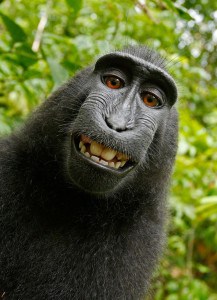When you follow the news on photography topics, you will have run across the “monkey selfie” story that went viral – twice – a few months ago. And yes, we have run the story ourselves, echoing the general media. But the case is by far not as decided as the headlines had suggested.

Let's tell the story in short: British award winning wildlife photographer David Slater had travelled to Indonesia to take images of the local wildlife and nature as he used to. The crested black macaque is an endangered species, so Slater went to take pictures of those wonderful creatures.
The curious monkeys are a friendly species, so they had no problem with Slater being in the vicinity, and over time they found the courage to inspect his equipment. As one of his cameras was unintended, a monkey started looking at the reflections in the lens, something it most likely never had seen before in his life. As monkeys are curious and capable (though probably not as smart as chimpanzees), it eventually even found out how the remote trigger works.
David Slater described this situation in an interview later:
At first it scared the rest of them away but they soon came back – it was amazing to watch. He must have taken hundreds of pictures by the time I got my camera back, but not very many were in focus. He obviously hadn't worked that out yet.
Somehow some of the images Slater had taken ended up on Wikipedia. It definitely was not the first time that a copyrighted image ended up on the site as contributors are uploading content even if they don't know the original source. In general, having those images removed requires a simple procedure for photographers when they figure out one of their copyrighted images is being used. And so did David Slater, the images were removed by Wikimedia.
However, after another look and probably some internal discussion, the Wikimedia Foundation has decided to re-publish the image with a note stating that “the image was taken by an animal and therefore can not be copyrighted”. A position that caused some uproar amonst photographers, especially those from the wildlife and nature community. The story was published widely in the photography community and even picked up by main stream media. There is another great interview with David here on Petapixel, where he explains his standpoint.
Then, a few months ago, another wave of media reported that the US Copyright Office “had decided” that images “taken by animals” could not be subject to copyright protection. Given the back story of the “monkey selfie” before, this news was taken as a decision on a specific case. Well, it wasn't. The sentence (and a few more) are part of a 1,222 page document published as a draft version by the USCO for future copyright assessments. It had (or has) no impact on images registered in the past, at least until now.
While there is no reasonable doubt that an animal has not the same legal rights as a human and therefore could not hold copyrights (a simple position the US Copyright Office and the UK have stated), it does not necessarily conclude that images taken under certain conditions without the photographer triggering the shutter would count as “taken by an animal”.
As a matter of fact, if that position would win in the end, it would outlaw a lot of images from copyright protection: Cameras triggered by motion or light sensors are very common amongst wildlife photographers; but thinking a step further what happens when “triggering the camera” is becoming the single criteria to who owns the copyright: It would mean that any photo assistant or second shooter would be the copyright holder and not the main photographer who sets up a shoot and usually takes all the financial and legal risks of his business.
All in all there is a lot at stake for a lot of the photography community, not just animal photographers. Luckily, the news spread in August were immature and the case (and other cases) are far from being resolved or decided. There is a good chance we will have to report about this case again in the future. Hopefully with a result that does not put many photographers work automatically into the public domain. We are sure none of our readers would like that to happen.
As a matter of fact, there is something you can do yourself: During the drafting period, the US Copyright Office accepts public feedback on the new rules. You can submit your personal opinion and position at their website, until the draft period runs out on or around December 15, 2014.
1 Comment
For the record, the US Copyright Office has stated in their official Compendium of U.S. Copyright Office Practices, 3rd Edition that to qualify for copyright protection, a work must be created by a human being. In section 306, they state “The Office will not register works produced by nature, animals, or plants.” And when citing examples of works specifically not eligible for copyright, the very first example given is: “A photograph taken by a monkey.”
From this, I think it may be taken that the Slater matter is done and settled as far as the U.S. Copyright Office is concerned.
Time to move on.